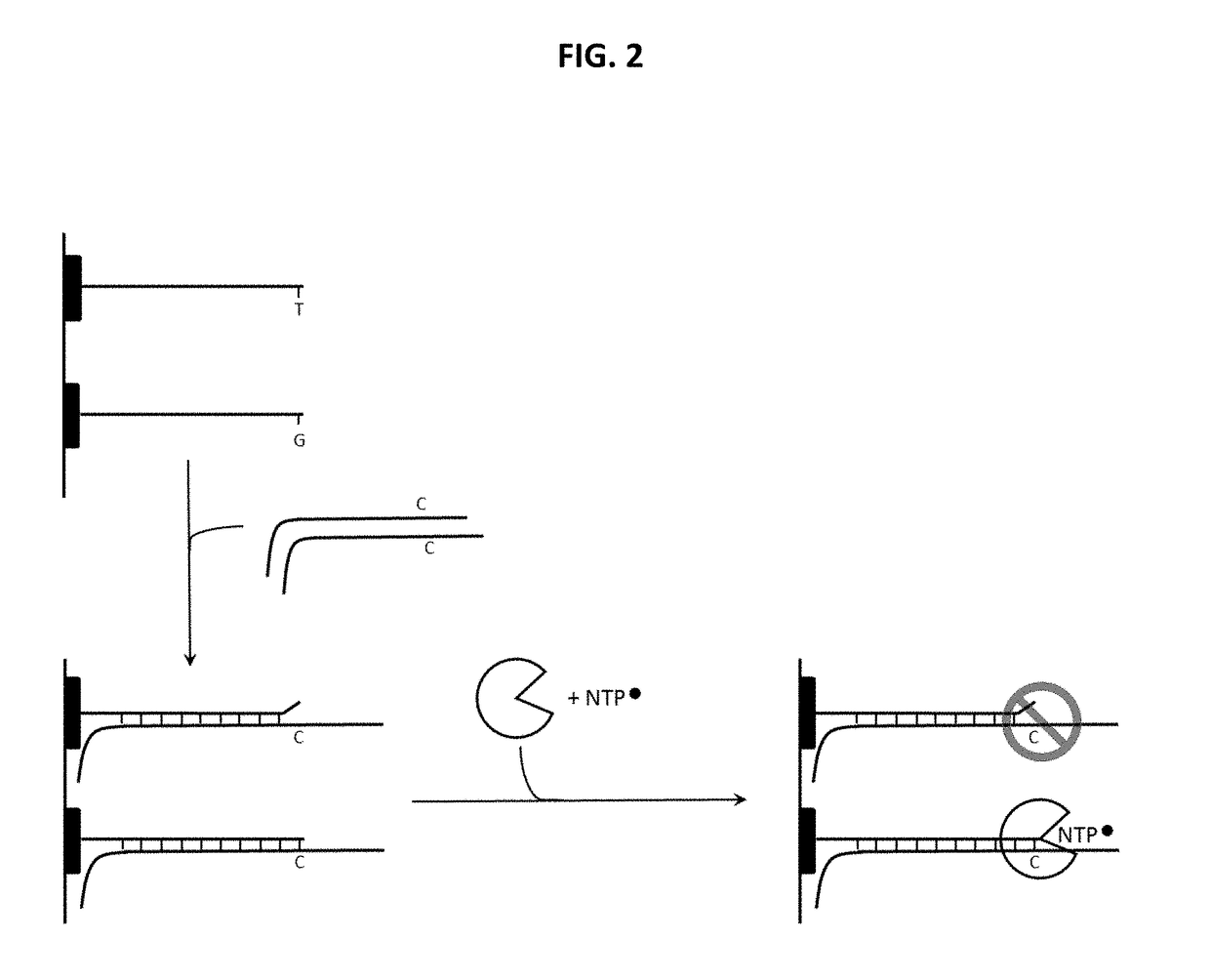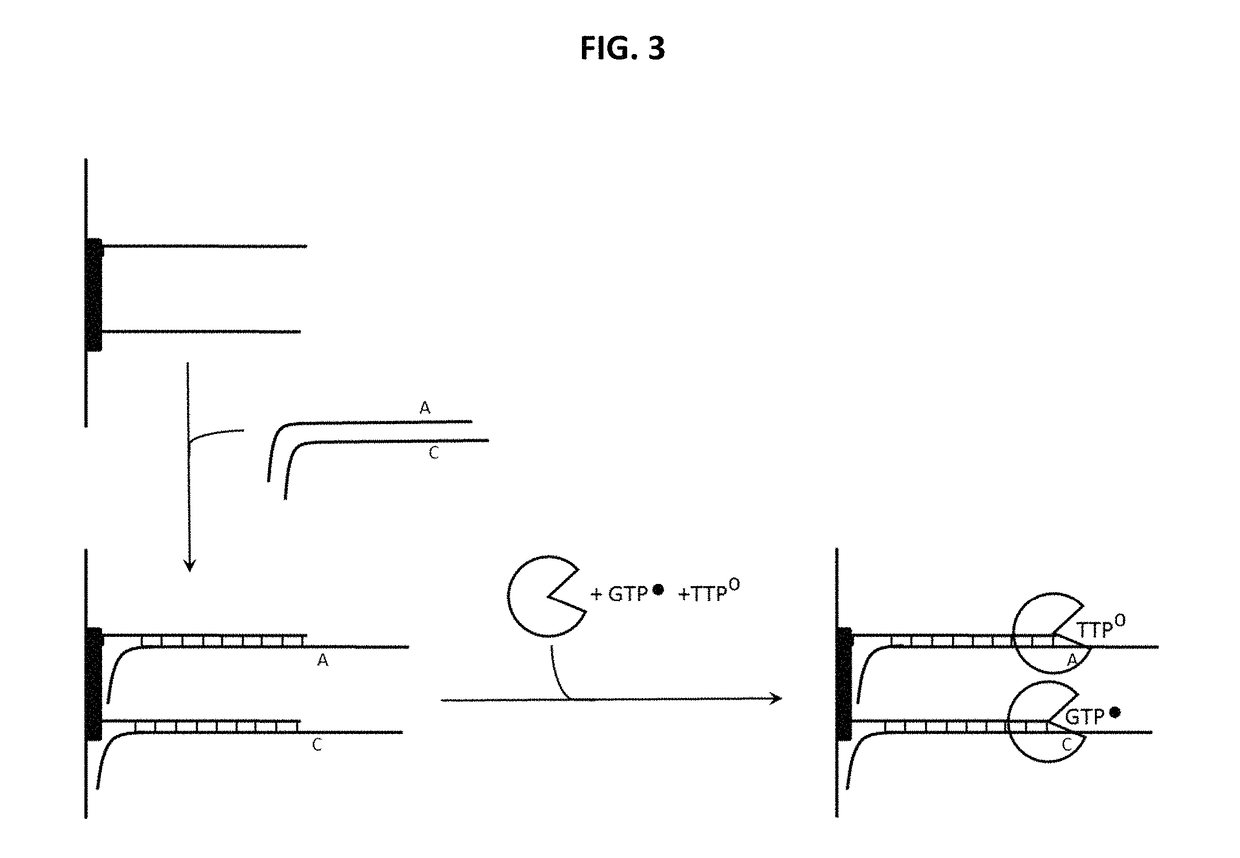Genotyping by polymerase binding
a polymerase and gene technology, applied in the field of genetyping by polymerase binding, can solve the problems of unfavorable scaling methods, significant differences in biological functions, and expensive and time-consuming available methods
- Summary
- Abstract
- Description
- Claims
- Application Information
AI Technical Summary
Benefits of technology
Problems solved by technology
Method used
Image
Examples
example i
Distinguishing the Next Correct Nucleotide from a Mismatched Nucleotide
[0138]Methods & Materials. Polymerase buffer: 20 mM Tris, pH 8, 300 mM NaCl, 5 mM DTT, 100 μM dNTP, 150 nM Kienow, 0.01% BSA, 0.02% Tween-20, 10 mM MgCl2. Exam buffer: 20 mM Tris, pH 8, 300 mM NaCl, 5 mM DTT, 100 μM dNTP, 150 nM Klenow, 0.01% BSA, 0.02% Tween-20. Incorporation buffer: 20 mM Tris, pH 8, 300 mM NaCl, 5 mM DTT, 0.01% BSA, 0.02% Tween-20, 10 mM MgCl2. Wash Buffer: 20 mM Tris, pH 8, 300 mM NaCl, 5 mM DTT, 0.01% BSA, 0.02% Tween-20.
[0139]FIG. 4 shows the results of a binding assay using polymerase, primed template, and nucleotide (either matched or mismatched with the next base in the template), where magnesium was present or absent during the binding assay. The first delivered nucleotide was dCTP (C:T mismatch) and the second delivery was dATP (A:T match). The solid line in FIG. 4 shows the results with Polymerase buffer. The pre-steady state rate constants were 0.0106 and 0.0084 for the match A and m...
example ii
Effect of Salt Concentration on Match / Mismatch Base Discrimination
[0140]The FORTEBIO® Octet instrument (Red384 or qk) (Menlo Park, Calif.) uses biolayer interferometry to measure binding reactions at the surface of a fiber optic tip. In this example, the tips were functionalized with streptavidin (SA) to enable binding to 5′ biotin labeled DNA templates hybridized with a primer that is complementary to sequences near the 3′ end of the template.
[0141]Experimental Conditions:
[0142]PhiX_matchC and phiX_matchA were loaded onto individual tips. Primer-template was loaded onto the tips at between 100 and 500 nM in 1-2×PBS containing 0.01-0.02% BSA and 0.01-0.02% Tween 20 (loading buffer). The FP2 primer was in 1.25-2 fold excess over template. Loading was monitored by change in signal and usually reached a plateau within 5 minutes at 30 degrees C. Tips were soaked in Loading buffer for 1-5 minutes to remove unbound DNA material. For base calling, the tips were soaked in solutions containi...
PUM
 Login to View More
Login to View More Abstract
Description
Claims
Application Information
 Login to View More
Login to View More - R&D
- Intellectual Property
- Life Sciences
- Materials
- Tech Scout
- Unparalleled Data Quality
- Higher Quality Content
- 60% Fewer Hallucinations
Browse by: Latest US Patents, China's latest patents, Technical Efficacy Thesaurus, Application Domain, Technology Topic, Popular Technical Reports.
© 2025 PatSnap. All rights reserved.Legal|Privacy policy|Modern Slavery Act Transparency Statement|Sitemap|About US| Contact US: help@patsnap.com



